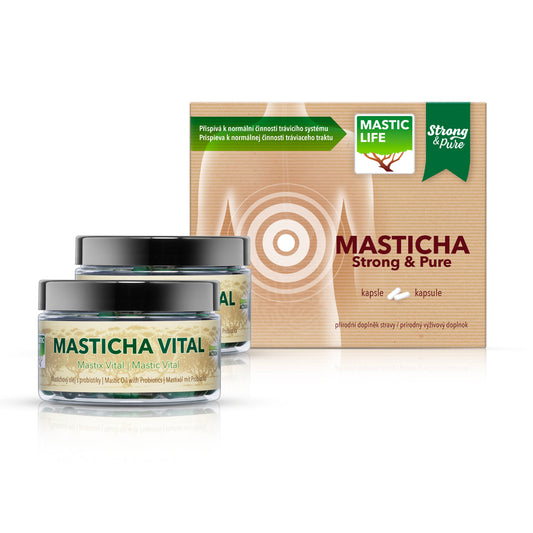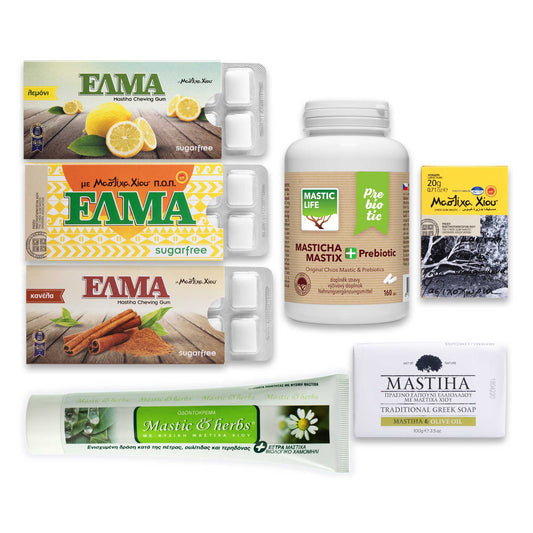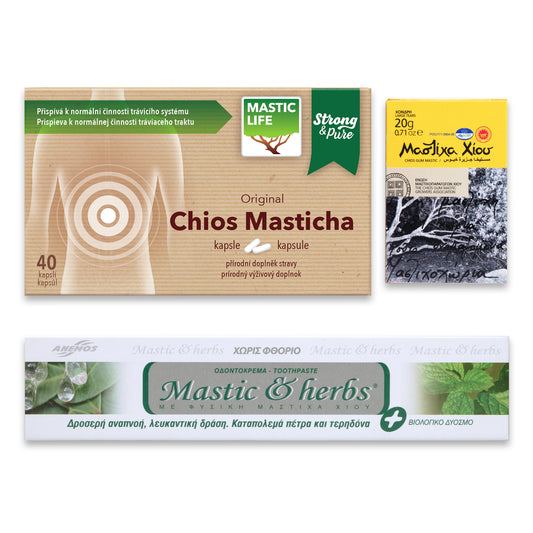Mastic Tree
A mastic tree - Pistacia lentiscus var. Chia grows throughout the Mediterranean, but only in a small area in the south of the island of Chios has effective properties and only here it produces mastic gum.
What is a mastic tree?
The mastic tree (Pistacia lentiscus var. Chia), Greek Σχίνος (schinos) is an evergreen tree of the family Anacardiaceae. In the area of Mastichochoria in the south of the island of Chios, resin - mastic gum is obtained from the mastic tree.
What it looks like?
A mastic tree reaches a height of 2 - 3 meters, exceptionally up to 5 meters. It branches low to the ground and therefore often acts more like a shrub. It has a dark green oval pointed petals at the end forming a dense crown. It is undemanding and thrives on desolate, rocky and nutrient-poor soil. The roots protruding to the surface capture the morning dew and air humidity, so the mastic tree thrives even in very dry periods.
Due to the shallow root system, frost is dangerous for the mastic tree, but it is rare in the area of southern Chios. Mastic trees and similar varieties from its family are common vegetation in the whole Mediterranean area, but only on Chios are rare "tears" obtained from it - mastic gum. And although the mastic tree grows all over the island, the effective mastic gum is collected only in its southern part, in the Mastichochoria area.
The uniqueness of this area and the local mastic gum production is due to several factors - a combination of:
- soil
- climatic conditions
- long-term breeding
Growth and reproduction of mastic trees
The mastic tree grows very slowly and becomes fully developed between 40 and 50 years of age. It can live more than 100 years. The mastic tree spreads shoots with relatively little success. The thriving branch is cut off from the plant and shallowly pushed into the ground. At the same time, only a few tickets remain at the top. The graft is irrigated only in the hot summer, otherwise it will not be taken care of in any way, even after a new plant appears.
Mastic Gum Production
The tree gives mastic after 5th or 6th year of life. The maximum production is after 15 years of life. After 70 years,the production of mastic from the tree is minimal. The average annual yield of one plant is 150 - 180 grams of raw mastic gum. But there are exceptions: the champions give half a kilo of mastic and, conversely, outsiders with a yield of 10 grams.
For the mastic gum, male trees are usually grown. Mastic gum production is positively affected by the space between the individual trees and regular aeration and hoeing of the soil around the trees.
| Species | Description | Mastic Quality |
|---|---|---|
| Mavroschinos / Pyxari | Dark green leaves with blackened edges, narrow, pointed, asymmetrical | High quality, pure, low yield |
| Votomos | Bright green leaves, wider and less pointed than Mavroschinos | High yield, low quality, less common |
| Marouliotis / Kallimasiotis | Fleshy leaves with rounded tips, grown between Kallimasia and Tholopots | Moderate quality and yield |
| Platyfyllos / Pyrgousikos / Sidorakikos | Grown mainly in Pyrgi in recent years | Good quality, moderate yield |
| Livanos | Rare, smells slightly burnt, aroma like incense | Poor quality |
| Krementinos | Rarest, mastic does not solidify completely, yellowish color | Low quality |
The Association of Mastic Growers strives to preserve all cultivated species, because each of them has a different resistance to cold and disease, and because each of them is part of the legacy of the original breeders of mastic tree on Chios.

FAQ: Mastic Tree
What is a mastic tree?
A mastic tree (Pistacia lentiscus var. Chia) is an evergreen tree found on the island of Chios. It produces mastic gum, a resin with unique properties, which is harvested from the tree's resinous secretion.
How does the mastic tree grow?
The mastic tree grows slowly and takes about 40 to 50 years to fully develop. It thrives on rocky, nutrient-poor soil and can live for over 100 years.
What is the unique characteristic of the mastic tree on Chios?
The mastic tree on Chios is the only variety that produces the mastic gum. The specific soil, climatic conditions, and centuries of cultivation make the mastic from Chios unique.
Mastic for your gastrointestinal tract
-
 8-week treatment 🗓️
8-week treatment 🗓️Mastic 8 weeks
Regular price €78.00 EURRegular price€97.50 EURSale price €78.00 EURSale -
 60-day treatment 💪
60-day treatment 💪Mastic Gum Extra for 60 days
Regular price €139.00 EURRegular price€174.70 EURSale price €139.00 EURSale -
 Gift set 🎁
Gift set 🎁Mastic „Life with Mastic"
Regular price €58.00 EURRegular price€63.53 EURSale price €58.00 EURSale -
 Gift set 🌿
Gift set 🌿Mastic „Pure Mastic“
Regular price €29.90 EURRegular price€32.70 EURSale price €29.90 EURSale




